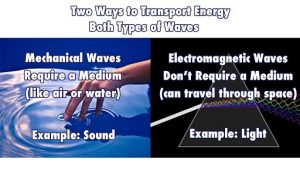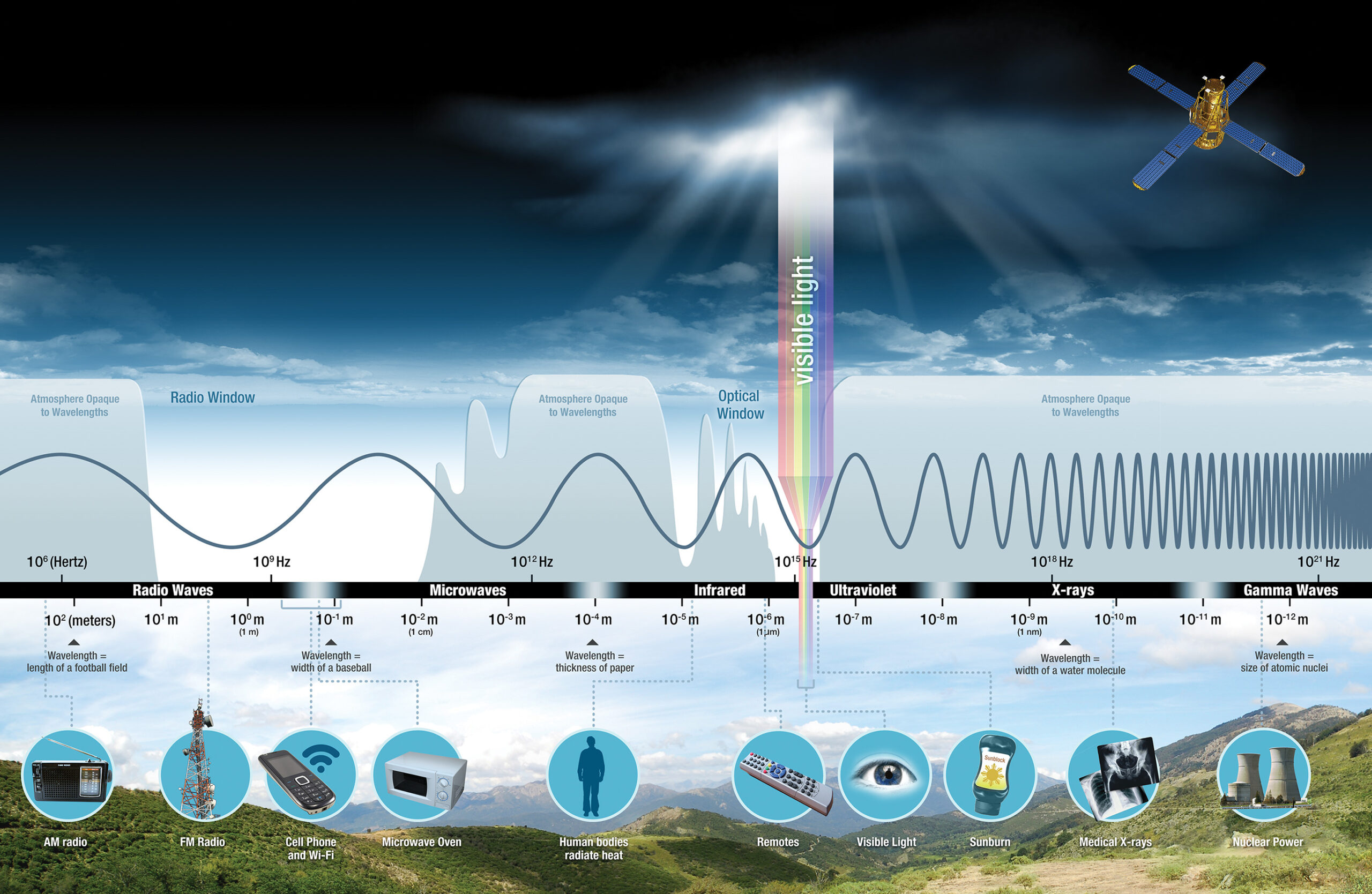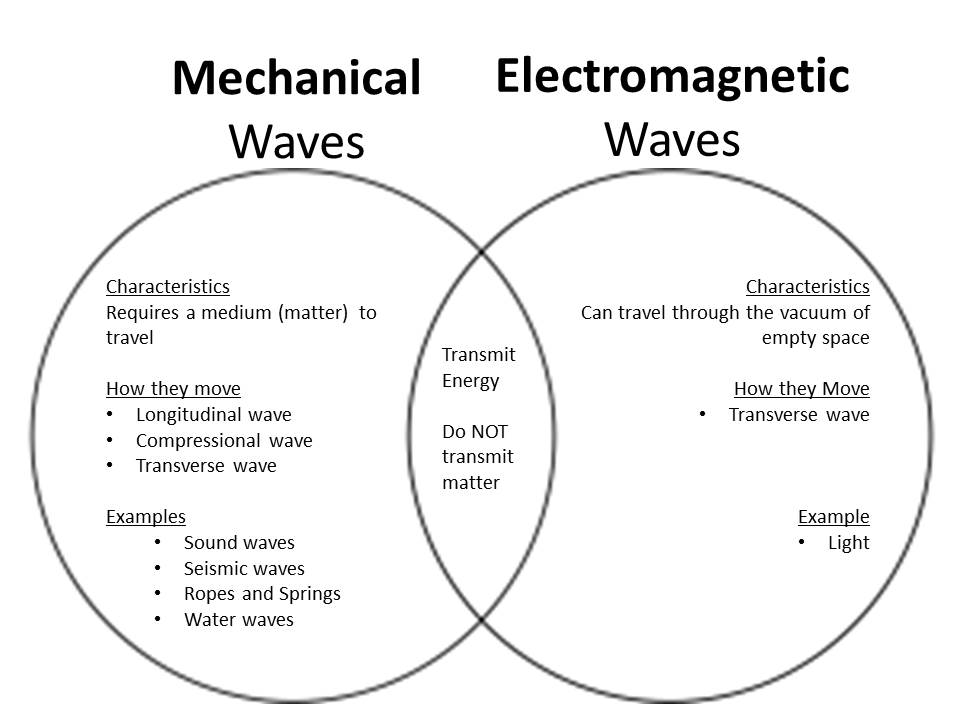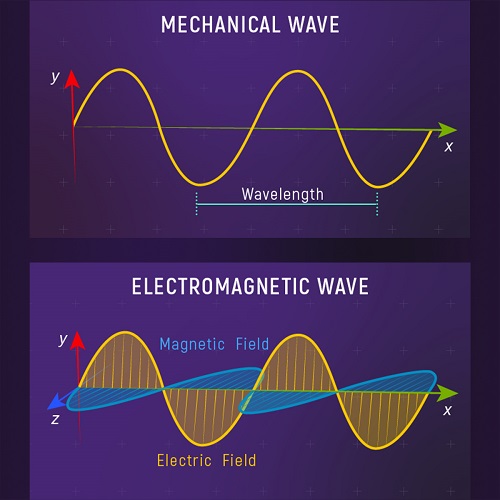Difference Between Mechanical and Electromagnetic Waves-Different waves and their features may be crystal evident to physicists, but the difference between mechanical and electromagnetic waves may be difficult to grasp for others. Even though both forms of waves transport energy around us, they differ in several ways.
Electromagnetic waves, unlike mechanical waves, may pass across a vacuum, or space. They require a mode of transportation, such as water or air. Mechanical waves, such as ripples in a pond, are examples of mechanical waves, but electromagnetic waves, such as light and radio transmissions, may travel through space’s vacuum. Different devices using mechanical and electromagnetic waves are provided by several Suppliers and Companies, different manufacturers, and a lot of distributors and there are a lot of Devices for Sale on Linquip.
There is a complete list of mechanical and electromagnetic wave services on the Linquip website that covers all OEM fleets. Linquip vendors can assist you with this. Please contact Linquip’s Waves Experts to discover more about how to connect with a diverse group of service providers who consistently deliver high-quality items.
How We Write the Blog Post about Difference Between Mechanical and Electromagnetic Waves
Writing a blog post about the difference between mechanical and electromagnetic waves can be an engaging and informative task for our team at Linquip. At Linquip, we strive to provide our readers with high-quality, comprehensive content that covers a wide range of topics in science, technology, engineering, and mathematics.
Prior to writing this blog post, we conducted in-depth research on the topic to ensure that we had a comprehensive understanding of the differences and similarities between mechanical and electromagnetic waves. This included reading multiple webpages, consulting with our team of experts, and analyzing graphs and diagrams to provide a visual representation of the concepts.
We started the writing process by defining the two waves and identifying their key characteristics. This included their different propagation mediums, frequencies, and the laws that govern them. We then compared the two waves in detail, highlighting their similarities and differences when it comes to frequency, speed, and absorption.
Throughout the writing process, we ensured that we used clear and concise language to make the content easily accessible to our readers. We also included visuals, such as graphs and diagrams, to enhance the reader’s understanding and make the content more engaging.
Overall, we are proud of the high-quality content that we have created. Our blog post is a comprehensive guide that helps readers understand the fundamental differences between mechanical and electromagnetic waves and how they differ in their behavior, properties, and practical applications. We hope that it will prove to be a valuable resource for our readers and help them understand the complex world of physics.
Introduction to Difference Between Mechanical and Electromagnetic Waves
There are various methods for dividing waves. One way to distinguish them is by the medium through which they travel. Mechanical and electromagnetic waves can be distinguished depending on the medium. Electromagnetic waves travel without the use of a medium, whereas mechanical waves require the use of one.
Mechanical waves do not travel in a vacuum, whereas electromagnetic waves do. For mechanical waves to travel, they require a medium such as water, air, or anything else. Mechanical waves are the ripples created in a pool of water after a stone is tossed in the center. Light and radio signals are examples of electromagnetic waves. An electromagnetic wave is simply referred to as a disturbance, but a mechanical wave is referred to as a periodic disturbance.
Because the propagation of mechanical waves is dependent on the elastic qualities of the material through which they flow, they are also known as elastic waves. The fluctuating magnetic and electric fields are what produce electromagnetic waves. Electromagnetic waves are formed by the vibration of charged particles, whereas mechanical waves are caused by wave amplitude rather than frequency. When mechanical and electromagnetic waves are compared, the former moves at a slower rate.
Longitudinal waves, transverse waves, and surface waves are the three types of mechanical waves. The medium moves perpendicular to the wave direction in transverse waves and parallel to the wave direction in longitudinal waves. Both transverse and longitudinal waves merge in a single medium in surface waves. In simple terms, an electrical wave travels in a vacuum, whereas a mechanical wave requires the use of a medium to travel.
Mechanical Wave Vs Electromagnetic Wave
The main difference between mechanical and electromagnetic waves is that mechanical waves cannot travel without the support of a medium, whereas electromagnetic waves can pass through a vacuum with the help of any medium.

Another significant distinction between the two is that the distance traveled by mechanical waves is determined by the elasticity of the medium in which they travel, but the characteristics of electromagnetic waves are determined by the action of magnetic and electric fields.
The speed of these two types of waves also differs. A mechanical wave takes far longer to travel than an electrical wave, which moves at the speed of light. A sound wave is an example of a mechanical wave, whereas microwaves and radio waves are examples of electromagnetic waves. For more information about their differences, visit here.
Comparison Table Between Mechanical and Electromagnetic Waves
| Parameter of Comparison | Mechanical Waves | Electromagnetic Waves |
| Medium | Cannot travel without a medium | Can travel without a medium |
| Factors affecting | Elasticity and inertia | magnetic and electric fields |
| Speed | Travels with the speed of the medium | Travels at the speed of light |
| Types | Transverse and Longitudinal | Only Transverse |
| Examples | Sound waves, surface waves | Microwaves, Radio waves, etc. |
What is a Mechanical Wave?
Mechanical waves, according to definitions, are waves created by oscillating matter, and their movement is what drives the wave forward. Mechanical waves fundamentally need a medium to travel and cannot travel in a vacuum.
As a result, a mechanical wave can only move in the direction that the medium carries it and its speed is restricted to that of the medium. This type of wave likewise demands an initial burst of energy to get it moving.
Longitudinal, transverse, and surface waves are the three forms of mechanical waves. When the particles of the medium oscillate parallel to the wave’s forward direction, a longitudinal wave is created.
When the particles of a wave vibrate perpendicular to the direction of movement, a transverse wave is created, whereas a surface wave is created when the waves move at the interface of two media. Ripples in a body of water are an example of a surface wave.
Various Types of Mechanical Waves
Transverse Waves
Consider a lengthy string. You hold the other end while tying one end to a tree to exert strain on the string. You then wiggle the string end you’re holding up and down, and you can watch the movement move the string down in the direction of the tree. By doing this, you move the medium (the string) in a direction that is perpendicular to or transverse to the direction of motion. In other words, you’re creating a transverse wave!
Longitudinal Waves
Compression waves and pressure waves are two more names for longitudinal waves. The displacement of the medium in longitudinal waves moves in the same direction as the wave. To understand this, picture a liquid in a tube with a piston or plunger at one end and a stiff wall at the other. The liquid (the medium) traveling down the tube experiences displacement and pressure changes as a result of your pressure application on the piston.
Surface Waves
The boundary between two dissimilar media is where surface waves travel. Examples include ocean waves and seismic waves, which frequently happen as a result of earthquakes. The medium’s molecules move in circles during surface waves; hence, they are neither transversely nor longitudinally oriented. They can be thought of as having both transverse and longitudinal components, though. Surface waves’ electromagnetic counterpart, ground waves, are discussed elsewhere in this text.
What is an Electromagnetic Wave?
Electromagnetic waves are produced once electrically charged particles accelerate and interact with other particles. No particles are oscillating in an electromagnetic field, but photons spread and generate a wave. Maxwell’s four laws govern electromagnetic fields.
An electromagnetic field is created by the interaction of changing electric and magnetic fields with directions that are 90 degrees apart. The directions of these fields are also perpendicular to the energy and wave propagation directions.

Electromagnetic radiation does not require a medium to propagate because it consists solely of oscillating electric and magnetic fields. As a result, they can travel across a vacuum. An electromagnetic wave can travel at the same speed as light. The rules of quantum electrodynamics regulate electromagnetic waves.
In other words, photons, which are uncharged particles that travel at the speed of light, make up electromagnetic waves. Energy, momentum, and angular momentum are all propagated away from the source via these waves.
The far-field is created when photons migrate away from their parent source and no longer require a constant supply of energy to keep them moving. The near field is the field that surrounds the parent charge that started the wave in the first place.
Main Differences Between Mechanical Wave and Electromagnetic Wave
The major distinction between mechanical and electromagnetic waves is that mechanical waves require a medium to travel, whereas electromagnetic waves can flow through a vacuum with the assistance of any material.
Another significant difference between these two is that the area covered by mechanical waves is determined by the elasticity of the medium in which they travel, but the properties of electromagnetic waves are determined by the action of magnetic and electric fields.

A mechanical wave moves far slower than an electromagnetic wave, which travels at the speed of light and contains photons as its principal elements.
A sound wave is an example of a mechanical wave, whereas electromagnetic waves include microwaves, infrared, radio waves, X-rays, ultraviolet rays, visible light, and gamma rays.
Mechanical waves are caused by oscillating matter, and the movement of the oscillating matter is what propels the wave ahead, whereas electromagnetic waves are caused by accelerating electrically charged particles.
Wave Motion
There are two sorts of waves that cause wave motion: mechanical waves and electromagnetic waves. Mechanical waves require a medium to transmit their energy. They are created as a result of the medium particles vibrating. They don’t move through empty space (vacuum). Sound waves and water waves are examples of low-speed waves. Because sound and water waves are generated by the vibration of medium particles, they are mechanical waves.

Electromagnetic waves are waves that travel through space and are accompanied by electromagnetic forces. They do not require a medium to go through. They have the ability to spread via all forms of media and unrestricted space. Their top speed is 300 million meters per second. Gamma rays, light waves, radio waves, microwaves, X-rays, ultraviolet and infrared rays are all examples of electromagnetic waves (which are emitted from the Sun).
We receive sunshine but are oblivious to the sound of solar explosions because sunlight is electromagnetic waves that can travel across free space, but the sound of solar explosions is mechanical waves that cannot.
Although they occur at the same time, we see lightning before hearing thunder because lightning is caused by electromagnetic waves, but thunder is caused by mechanical waves, and the speed of electromagnetic waves is significantly faster than the speed of mechanical waves.
Because there is no medium for sound waves to pass across in space, astronauts cannot hear each other’s voices directly. Because sound is made up of mechanical waves and light is made up of electromagnetic waves, sound requires a medium to travel through, but light flows through space.
Technological Applications of Waves
Sound mechanical waves have been used in the following technical applications:
- Sound waves are used to examine and treat human body equipment (ultrasonic waves).
- Stringed musical instruments (stringed musical instruments) include the violin, lute, and guitar. Flute or reed pipes are examples of pneumatic musical instruments.
- In broadcasting studios, amplifiers and sound distribution and control systems are employed.
Electromagnetic waves have been used in the following technical applications:
- The sets of surgical operations rooms are sterilized using ultraviolet (UV) light.
- Photographing bones to discover fracture sites, evaluating metal (mineral) raw materials in the industry to highlight mistakes, pores, and cracks in these minerals, and researching the inner structure of mineral crystals are all examples of how X-rays are employed.
- Gamma rays are utilized in medicine for the detection and treatment of swellings (tumors).
- Photographic cameras, television cameras, and light displays all employ visible (seen) light (data show).
- Infrared (IR) beams are utilized in night vision frameworks utilized by present-day military powers, they are utilized in inaccessible detecting instruments to capturing the Earth’s surface utilizing satellites and they are utilized in cooking nourishment since these beams have warm impact properties, they are utilized in making farther sets to control and work electric sets (TV, DVD, air conditioner, etc.).
- In medicine, UV radiation, X-rays, and gamma rays are employed. In photography, infrared rays and visible light are employed. Remote controls operate electrical equipment without the use of media because they employ infrared rays (electromagnetic waves) that may travel through space. In the mining sector, X-rays are used to inspect mineral raw for mistakes, porosity, and fractures.
Conclusion
- Mechanical and electromagnetic waves are both capable of transporting energy from one location to another. These two forms of waves are the most often seen and studied among the numerous types of waves in physics.
- The key distinction between mechanical and electromagnetic waves is that mechanical waves cannot travel without the assistance of a medium and can only travel at the speed of the medium, whereas electromagnetic waves can travel through a vacuum with the help and support of any medium and can travel at the speed of light.
- Mechanical waves are caused by oscillating matter, and this type of wave also requires an initial amount of energy to get started, whereas electromagnetic waves are caused by accelerating electrically charged particles, which then influence other particles in the vicinity.
- An electromagnetic wave can only be a transverse wave, but a mechanical wave can be longitudinal, transverse, or surface waves. Ripples in a water body are an example of a mechanical wave, whereas microwaves, radio waves, and ultraviolet rays are examples of electromagnetic waves.
- Mechanical waves’ distance traveled is determined by the elasticity and inertia of the material they travel through, but electromagnetic waves’ properties are determined by the operating magnetic and electric fields. An electromagnetic field propagates energy, momentum, and angular momentum, whereas a mechanical wave simply propagates the energy within the particles.
- Mechanical waves do not move in a vacuum, but electromagnetic waves do. A mechanical wave is the ripples created in a pool of water after a stone is tossed in the center. Light and radio transmissions are examples of electromagnetic waves.
- Wave amplitude, not frequency, is what causes mechanical waves. The oscillation of charged particles produces electromagnetic waves. An electromagnetic wave is simply referred to as a disturbance, but a mechanical wave is referred to as a periodic disturbance.
FAQs about Difference Between Mechanical and Electromagnetic Waves
Why is the main difference between mechanical and electromagnetic waves?
The universe is filled with waves. Mechanical waves, which must pass through a medium of matter, and electromagnetic waves, which do not (which do not require a medium of matter to move through).
Is it necessary matter to travel mechanical or electromagnetic?
The waves known as mechanical waves need a medium to transfer their energy from one place to another. Mechanical waves cannot go over areas of space where there are no particles since they depend on particle contact to carry their energy.
Can mechanical waves travel through space?
Only via matter can a mechanical wave’s energy travel. The medium is the substance through which the wave travels (plural, media). Water, a liquid, serves as the wave’s medium in the illustration above. Yet, any state of matter, including a solid, can act as the medium for a mechanical wave.
Can mechanical waves travel through matter?
Mechanical waves move far more slowly than electromagnetic waves, which move at the speed of light. Electromagnetic waves are called a disturbance, while mechanical waves are called a periodic disturbance.
Are mechanical waves faster than electromagnetic waves?
In contrast to mechanical waves, electromagnetic waves may travel without a medium. This implies that electromagnetic waves may pass not just through solid objects like air and rock but also through empty space.
Download Difference Between Mechanical and Electromagnetic Waves PDF
linquip.com-Difference Between Mechanical and Electromagnetic Waves
Watch Videos about Difference Between Mechanical and Electromagnetic Waves
For more information about Difference Between Mechanical and Electromagnetic Waves, watch this video about Difference Between Mechanical and Electromagnetic Waves.
Read More In Linquip
- Difference Between Current and Static Electricity
- Difference between General Relativity and Special Relativity
- Difference between Orbit and Orbital
- Difference between Density and Relative Density
- Difference Between Hydraulics and Pneumatics
- Difference Between 2 Stroke and 4 Stroke
- Difference Between dB and dBm




Assume your reader has no prior knowledge of waves; and this from the second paragraph in the article: “Electromagnetic waves, unlike mechanical waves, may pass across a vacuum, or space. They require a mode of transportation, such as water or air.” As I read it, electromagnetic waves in fact require a mode of transportation, such as water or air. I believe that will cause the reader immediate confusion.
Thanks for visiting our website, Greg! We first apologize for any inconvenience experience you had with this article. Your valuable comment will be considered for the next update of the post.